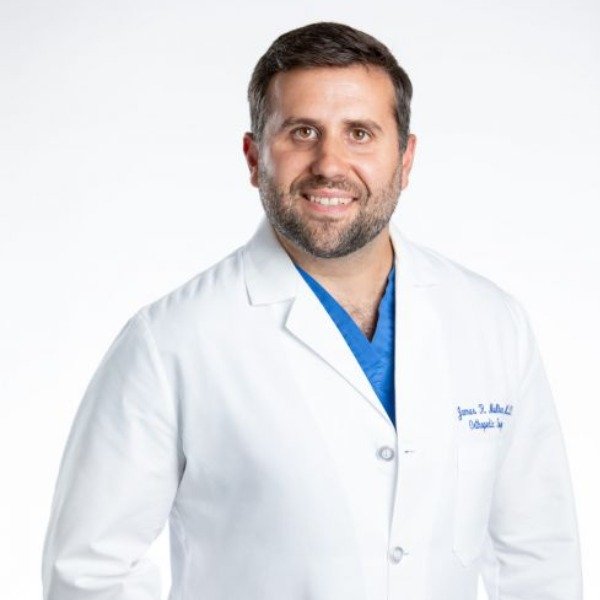Rotator Cuff Injuries Can Get Better with Rest, But Need To Be Evaluated
By Andrew Wilson
James R. Mullen, M.D.
James R. Mullen, M.D., knows all about rotator cuff tears from both sides of the examination table.
His first experience with a rotator cuff injury came while playing lacrosse in high school. He battled through the injury for multiple years prior to having it surgically repaired and eventually went on to play NCAA Division I football and lacrosse at Dartmouth College. Those injuries gave him a perspective that aids him as an orthopedic surgeon.
“I believe I can better relate to what my patients are going through because of my experiences receiving treatment for my own injuries,” said Dr. Mullen, who practices with St. Clair Medical Group and has treated many patients for rotator cuff injuries, both surgically and non-surgically.
While sports fans may be most familiar with rotator cuff injuries in baseball or tennis, it’s not just athletes that are susceptible. Dr. Mullen says anyone can find themselves with pain, weakness, limited range of motion, or some other type of instability around the shoulder.
The rotator cuff is a collection of four muscles and tendons which connect and stabilize the ball-shaped part of the humerus (upper arm) to the socket (scapula/shoulder blade). A rotator cuff injury usually occurs at the level of the tendons where they attach to the ball of the ball and socket joint. This bone/tendon relationship is critical in allowing for normal, pain-free movement.
“At times, a rotator cuff injury can result from a fall or some other traumatic injury. More often, however, patients can’t recall a specific event that caused the pain or decreased function,” he said. “Most commonly, people can get by without surgery after a rotator cuff injury. Especially if it’s not a complete tear – also known as a ‘full thickness tear’ – of one of the four tendons.”
While some people experience a partial or complete tear of one of the tendons that comprise the rotator cuff, a patient may also experience pain from inflammation due to repetitive activities. If that is the cause, a combination of rest, anti-inflammatory medication, therapy, and/or a steroid injection will usually alleviate the problem
“I usually take a cue from the pain that my patient is feeling. A complete rotator cuff tear can become so painful that surgery is the only option,” Dr. Mullen said. “Once we put the cuff and tendons back in place, then the body has to heal, and that takes time. Generally speaking, recovery time is about three to six months.”
Although surgery is usually not required for most rotator cuff problems, Dr. Mullen says he regularly sees patients who wait too long to have the injury evaluated as “they believe that it can’t be a rotator cuff injury because they can still move their shoulder.” This is a mistake. “If you have pain that is not going away, it should be evaluated,” he said.
“The shoulder can move in many different directions, and the four muscles each have different roles to enable that movement,” he explains. “If you tear one or two tendons, then you may still have good movement, but, over time, these torn tendons may retract so far away from they are supposed to be attached that the tear can become irreparable.”
Dr. Mullen has a simple rule of thumb on what to do if you’re experiencing shoulder pain.
“Shoulder pain that lasts for two to three months and isn’t responding to rest or anti-inflammatory medication needs to be checked,” he said. “If a tear is left alone for too long, it sometimes cannot be repaired surgically. The good news is, if you are within a year from the time you first had pain, it is generally fixable. Nevertheless, even if the rotator cuff cannot be fixed, there are still excellent options, such as Superior Capsular, Reconstruction or reverse total shoulder replacement.”
Assessing the injury is always the first step, but Dr. Mullen takes many factors into consideration before proceeding with surgery. If the patient has good function – meaning they can raise their arm above shoulder height and can do normal daily activities – surgery is usually not recommended and can be treated with rest, physical rehabilitation, and possibly injections. Poor function or even good function with a lot of pain may result in a different course of treatment. Even still, there are related questions to answer.
“I always take into consideration how independent the patient is and whether they have any help at home. If they are working, I consider how long will they be off work, and the impact that will have,” he said. “Most importantly, I want to tailor the treatment to the specific goals of the patient. Everything surrounding the surgical experience is important, not just what happens on the day of surgery.”
A Pittsburgh native, James R. Mullen, M.D., earned his bachelor's degree with honors at Dartmouth College. He received his medical degree with honors from Temple University School of Medicine in Philadelphia and completed his orthopedic surgical residency at the Hofstra University-Northwell Health System in New York City where he served as administrative Chief Resident. Dr. Mullen also completed a fellowship in hand, upper extremity and microvascular surgery at New York University Medical Center. He has been published in numerous orthopedic textbooks and medical journals, and has presented research at national conferences. He is double board certified by the American Board of Orthopedic Surgery and the American Board of Orthopedic Surgery – Certificate of Added Qualification in Surgery of the Hand.
Dr. Mullen sees patients at Dunlop Family Outpatient Center, located at 1000 Bower Hill Road, Suite 7300, Pittsburgh, PA, 15243. His office can be reached by calling 412-942-7262.

